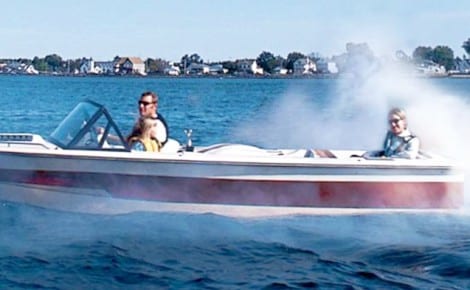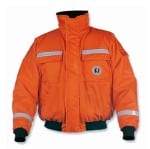 By Bob Currie, Vessel Examiner
By Bob Currie, Vessel Examiner
U. S. Coast Guard Auxiliary Station Galveston Flotilla
Now that we have had a couple of cool spells, it is time to talk about the dangers associated with trying to stay warm on the water. The key to safely operating in cool weather is to dress accordingly. Two dangers of operating in cool weather are carbon monoxide poisoning and hypothermia due to immersion in cold water. This column will address those two issues.
The Station Galveston Flotilla of the US Coast Guard Auxiliary operates out of the USCG Station Galveston base on Galveston Island. They aid the Coast Guard by providing maritime observation patrols in Galveston Bay; by providing recreational boating vessel safety checks; and by working alongside Coast Guard members in maritime accident investigation, small boat training, watch standing, and procurement.
Carbon Monoxide and Boats
Any boat with an engine can be a source of carbon monoxide. Last year about this time we had a couple who were charging their batteries with a gasoline-powered generator on their boat succumb to CO poisoning. Because the weather had turned cool, the couple had lowered the plastic side windshields to protect them from the wind. On average every year 6 boaters die and 31 are injured due to CO poisoning. These figures are based on a ten-year average even after the significant efforts put forth by the boating industry to eliminate CO hazards. The danger not only applies to boat occupants, but includes swimmers in the water near a boat that is producing CO. CO is heavier than air and will float just above the water. An idling engine can produce significant levels of CO around a boat that is stationary when the wind is not moving.

How to Reduce Your Chance of Exposure to CO
There are several recommendations from the Coast Guard for reducing boaters’ chances of being exposed to CO, and of course having a CO detector aboard is essential if you have an enclosed area where CO could accumulate, such as a cabin or a toilet.
- Use inboard engines equipped with catalyst technology that greatly reduces the amount of CO flowing out of the exhaust system. Boats that are being re-engined should have the old gasoline engines replaced with catalyzed engines.
- Gasoline or propane generators that are installed on boats should be low or no CO engines. Remember: carbon monoxide is odorless.
- Houseboats should have low or no CO generators installed and should have a dewatered vertical stack exhaust system installed as shown in the American Boating and Yacht Council Standard P-1.
- All boats with enclosed accommodations should have marine rated CO detectors installed. Side shields may keep you warm, but they can be dangerous if your engine or generator is putting out CO.
How Much CO Does it Take?
The following chart shows that the effect of CO depends upon the amount of CO concentration in the air. CO poisoning can occur over months of exposure to a light concentration, such as is with the case of a faulty furnace in your home.
Effects of carbon monoxide in relation to the concentration in parts per million in the air:
| Concentration | Symptoms |
| 35 ppm (0.0035%) | Headache and dizziness within six to eight hours of constant exposure |
| 100 ppm (0.01%) | Slight headache in two to three hours |
| 200 ppm (0.02%) | Slight headache within two to three hours; loss of judgment |
| 400 ppm (0.04%) | Frontal headache within one to two hours |
| 800 ppm (0.08%) | Dizziness, nausea, and convulsions within 45 min; insensible within 2 hours |
| 1,600 ppm (0.16%) | Headache, increased heart rate, dizziness, and nausea within 20 min; death in less than 2 hours |
| 3,200 ppm (0.32%) | Headache, dizziness and nausea in five to ten minutes. Death within 30 minutes. |
| 6,400 ppm (0.64%) | Headache and dizziness in one to two minutes. Convulsions, respiratory arrest, and death in less than 20 minutes. |
| 12,800 ppm (1.28%) | Unconsciousness after 2–3 breaths. Death in less than three minutes. |
Beating Hypothermia- Dress for the Water Temperature
The best way to survive accidental immersion in cold water is to wear a life jacket. It will keep your head above water, keep you afloat, and provide a measure of thermal protection against hypothermia. The effects of cold water immersion are predictable and well documented by what is known as the 1-10-1 Principle:
– 1 minute: Upon immersion in cold water, the body reacts with an involuntary gasp, followed by hyperventilation of up to 10 times regular breathing (if the head is underwater during that initial deep gasp, a person can inhale enough water to drown). Avoid panicking; breathing will return to close to normal.
– 10 minutes: A person immersed in cold water will become incapacitated as limb muscles stop working and prevent swimming or self-rescue, so swimmers should attempt to rescue themselves before incapacitation becomes a factor. If this is not possible, try to get as much of the body out of the water as possible to delay the onset of hypothermia.
– 1 hour: After about 60 minutes (depending on the water temperature), the body continues to cool. The resulting hypothermia can create a range of symptoms from confusion to unconsciousness, eventually leading to death.
If you boat in cold weather, you may consider purchasing what is known as a float coat. It is a combination bomber-style jacket and Coast Guard Approved Type III life jacket.  They keep you warm both above and in the water.
They keep you warm both above and in the water.
They make camouflage versions for duck hunters, but you really should get a high visibility version for open water use. The quicker you are seen and recovered from the water, the more likely you are to survive. The affects of hypothermia continue even after you are pulled from the water. If you don’t have a float coat, then wear layers of clothing under your life jacket. Do not wear cotton. Cotton has no ability to keep you warm when wet. Only synthetic materials have the ability to trap heat when wet.
Summary
Carbon monoxide poisoning and immersion hypothermia are two real dangers of winter boating. If you have any type of enclosure on your boat such as a toilet, cabin, or your boat is equipped with plastic side shields, you should also equip your boat with a carbon monoxide detector. You can also help protect yourself from hypothermia due to accidental immersion by wearing a float coat or wearing layers of clothing under your life jacket.
For more information on boating safety, please visit the Official Website of the U.S. Coast Guard’s Boating Safety Division at www.uscgboating.org. Questions about the US Coast Guard Auxiliary or our free Vessel Safety Check program may be directed to me at [email protected]. I am available to perform free Vessel Safety Checks, and I will come to your location to perform them. SAFE BOATING!
[11-11-2019]

 Posted in
Posted in 























